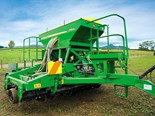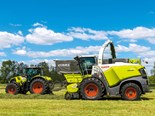Test: Faresin 9.30C Agri GLS
Farm Trader takes the Faresin 9.30C Agri GLS model for a test drive. The Italian-designed and made Faresin telehandler is one of the newer machines to the Jacks Machinery line-up.
.jpg)
The Faresin telehandler is one of the newest machines to be added to the fleet at Jacks Machinery, which is also a Case IH dealer in the region.
Brucie Donald from Jacks Machinery has sold more than his fair share of telehandlers over his decades in the machinery business and is quite the fan of the Italian-made Faresin range.
"It presents at a good price point, which allows farmers and contractors the flexibility of adding a telehandler to their line-up of machinery," he says.
"The telehandler is one of those machines that you don’t realise just how versatile they are until you have one on-site and realise just how useful it proves."
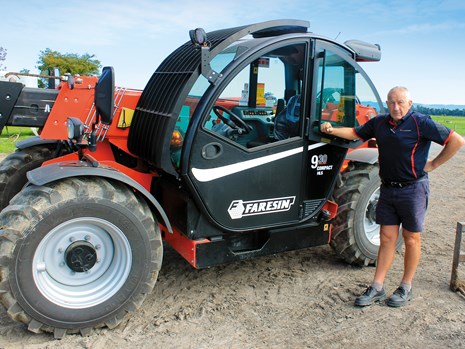 |
|
The Jacks Machinery expert on all things Faresin – Brucie Donald
|
Test time
Our test machine for the day was the Faresin 9.30C Agri GLS. The 9.30C is self-explanatory really: acknowledging the nine-metre reach and three-tonne lift capacity, with the C standing for Compact. The Agri at the end relates to the back end of the machine where you will find Cat II 3-point linkage, with the same three-tonne lift capacity as the front, as well as trailer hitch and mechanical PTO. This makes it a fairly useful and versatile machine to have around.
The Faresin was being used for an array of jobs on a dairy farm just out of Whakatane. On the morning I arrived, it was ready to load the mixer wagon with silage and minerals to be fed on the feed pad later in the day.
 |
|
The well-built heavy headstock
|
Telehandlers are designed for loading tasks. They can do it safely, with sensors warning you if you’re trying to operate the machine outside its safety margin.
In the cab is a light display unit that tells you whether the load is okay or not. Faresin equips its compact range of telehandlers with Euro hitch implement attachments, so using existing farm tractor attachments is a breeze, and presents no bother to a machine of this size.
The benefits of not needing to replace all of the loading attachments is a significant cost-saver if considering purchasing a telehandler over a tractor FEL combination.
 |
|
Easy-to-read LCD and gauge display
|
The Faresin is equipped with backing beepers to let those around you know what the machine is doing, which is a worthwhile safety feature, as like many telehandlers, rear visibility isn’t the best. One downside with the rear linkage and drawbar is that there’s no way of seeing out the back window when you’re getting close. It’s pretty much a two-person job hooking something on, although, a mirror over the back end or a camera kit would also solve this small issue.
Using the Faresin to work with grass silage, it didn’t take long to fill the wagon with grabs of grass from the stack. The reach of a telehandler definitely makes loading wagons easy. Instead of unhitching the mixer wagon, to connect the silage wagon to the tractor, we made use of the Faresin’s trailer hitch and hydraulic remotes. It was interesting to see this in action. The transmission coped well, and we had the cows fed in no time. There was no issue with lack of hydraulic oil flow or drive to the wheels due to the mechanical creeper design.
 |
|
Euro hitch making use of existing farm attachments
|
Operation
Like most telehandlers, the Faresin is fairly straightforward to operate. The dual range hydrostatic gearbox has a max speed of 40km/hr on the road. In Low, it operated within 0–20km/hr comfortably, and this worked fine on farm with loading and feed out duties.
The gearbox also incorporates a mechanical creeper function. This is useful when using the telehandler for more tractor-type tasks such as feeding out or using the PTO and linkage so all the hydraulic flow is not robbed for other functions, leaving nothing left to drive the machine.
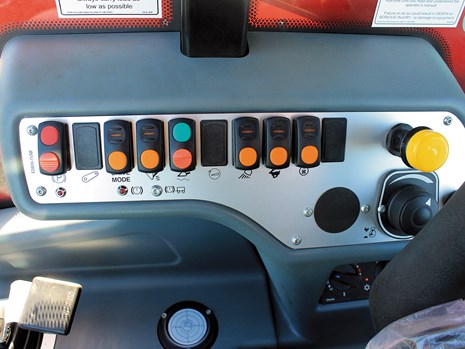 |
|
Simple layout of function control buttons and PTO switch
|
For tractor-type tasks, the hand throttle allows you to set the rpm, which is essential for PTO work. It also works well to keep the base revs above idle for whatever work is being done with the boom. I like the hydraulic pin lock on the Euro hitch implement attachment. Running through the same line as the third service valve, a tap at the headstock switches hydraulic flow between the two functions.
Inside the cab, the electro-proportional joystick controls most of the functions. Boom control is on the joystick, with the left toggle switch extending or shortening the boom reach, while the right-hand toggle controls third service, and forward/reverse is on the back of the joystick (fwd/rev can be switched to the steering column stalk). The colour dash shows details such as gear/direction/steering mode, of which there are three (like most telehandlers). Surrounding the colour display there are gauges to show speed/rpm/fuel/temp.
 |
|
Safety warning system display for lifting within machine parameters
|
Cab comfort
Faresin offers one of the largest cabs available in the compact telehandler market, which they have named the Queen Cab. The curved glass roof provides great visibility whether the boom is down, or up loading. The external ROPS structure protects the operator should anything ever fall onto the cab. The full door feels sturdy and with a swing back top window still provides fresh air when not working in dusty environments. With the door shut there is heating and cooling through the aircon unit to keep the operator comfortable.
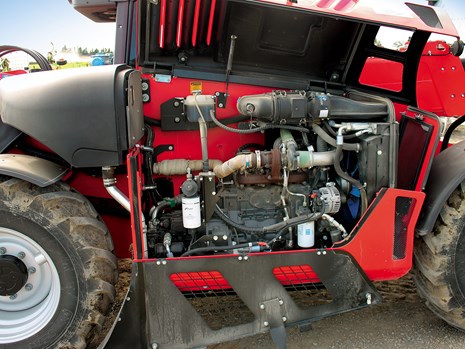 |
|
Easy servicing access with a two-piece side cover
|
The cab layout is modern with paddle buttons along the right controlling most functions. The buttons for both the park brake and transmission are probably going to be used more than most and are located closer to the joystick.
The steering column was easily adjusted to suit different drivers, the seat was obviously pretty comfortable because in wheel loaders/telehandlers you feel every bump, and I don’t recall being bounced around the cab. Externally there is a full LED lighting package as standard which is nice to see, rather than having to option it for an additional cost.
 |
|
The 9m two section boom has more than enough reach for farm jobs
|
Engine
Fitted with an Iveco Tier IIIA power plant producing 130hp, the Faresin 9.30C wasn’t lacking in power. Should you need to use the mechanical rear PTO, there’s still 106hp available at the shaft, which is pretty good I thought.
Running a 110-litre/min hydraulic pump seemed pretty effortless and provided smooth power and control while on the move and operating boom functions. I’m not sure if they will keep running the Tier III engine for markets such as New Zealand and Australia, where we tend to prefer the simplicity of non-AdBlue machines, or move to Tier4B engines, which European regulations are requiring.
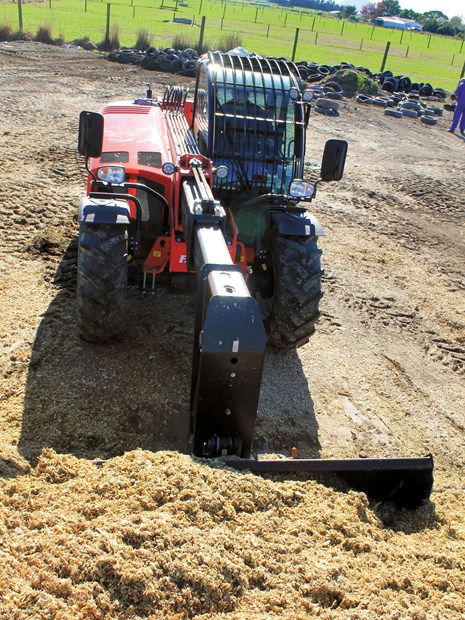 |
|
ROPS cab protection with LED lights
|
Another development already in the pipeline for Faresin is electric-powered telehandlers, so we may have one of those to check out in the future.
Mounted on the right-hand side, the engine is easily accessible for checking oils daily, with a sight glass on the 150-litre hydraulic tank and dipstick for engine oil. A two-piece engine cover makes life easier at service time for accessibility.
Servicing requirements are 300 hours for the engine and 1000 hours for hydraulic/transmission oil. With these machines being well built and using commonly available parts, there should be no problem getting your local service agent to do the servicing, or even better do it yourself.
 |
|
Feeding out silage and making use of the rear hydraulic service valves
|
Summary
With a 40-year history in the telehandler and mixer wagon business, Faresin seems to have things pretty well sorted. I wasn’t entirely sure what to expect initially, however, build quality was equal to that of other machines in this category. Engine power and hydraulic flow certainly weren’t lacking, which are key factors for speed and function of a telehandler. At the end of the day, you could drive away in a Faresin telehandler for quite a few less dollars than most other brands, and have it do the same job and bring all the benefits a telehandler offers in terms of versatility and functionality.
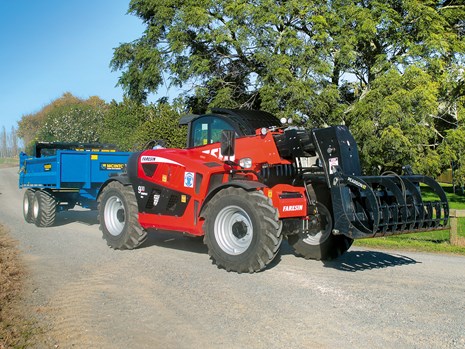 |
|
The Faresin 9.30C: a truly versatile farm workhorse
|
Faresin 9.30C Agri GLS specifications
|
Engine |
Iveco Tier IIIA |
|
Hp/kW |
130/93 |
|
Transmission |
Hydrostatic 2-speed/40km/hr with mechanical creeper |
| Hydraulic pump | Gear pump 110L/min @230BAR |
|
Boom hitch |
3T Euro, hydraulic locking |
|
Boom sections |
2 |
|
Boom reach |
8.9m |
|
Max horizontal reach |
5.9m |
|
Rear linkage |
3T Cat II |
| Rear service valves | 2 double acting |
| PTO | Mechanical, 106hp@PTO (540/1000) |
| Weight | 6950kg |
|
Length |
4781mm |
|
Width |
2117mm |
|
Height |
2260mm |
|
Ground Clearance |
350mm |
|
Tyres |
405/70–24 |
| Hydraulic oil | 150L |
Pros
- Euro hitch headstock on all Faresin telehandlers up to 3T lift capacity
- Good transmission, 2-speed hydrostatic with mechanical creeper gears for tractor type tasks
- Hand throttle – a handy feature
- Price point competitive compared to other brands of similar spec (Agri or standard)
- 2-piece engine cover for service accessibility
- Linkage/PTO provides back-up in case of other machinery break downs on farm
- Well-built and finished
Cons
- No rear mirror for linkage/drawbar hooking up, or camera would also be a good option
Find new and used farm machinery for sale in NZ
Keep up to date in the industry by signing up to Farm Trader's free newsletter or liking us on Facebook










.jpg)
.jpg)
